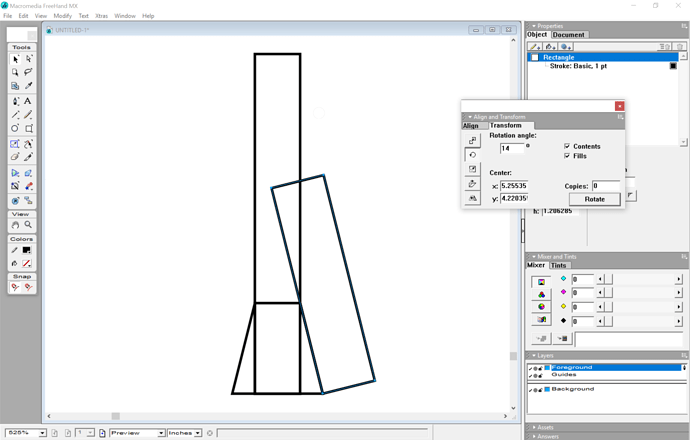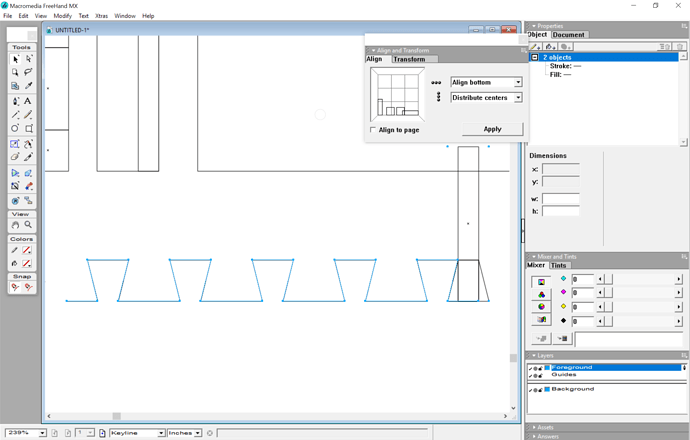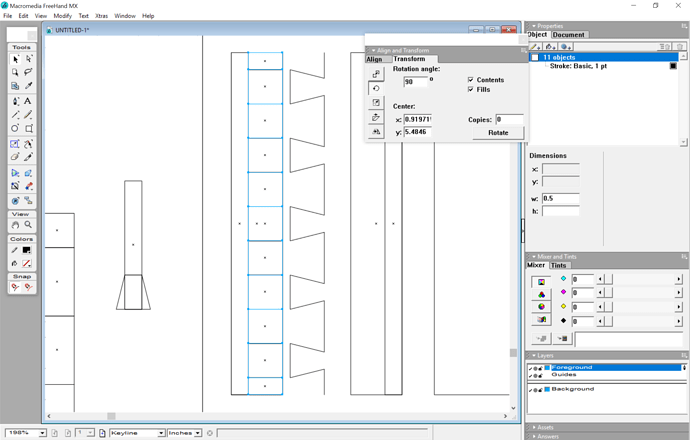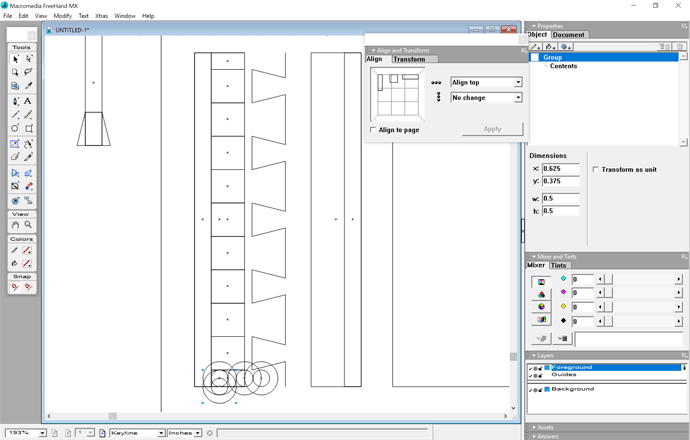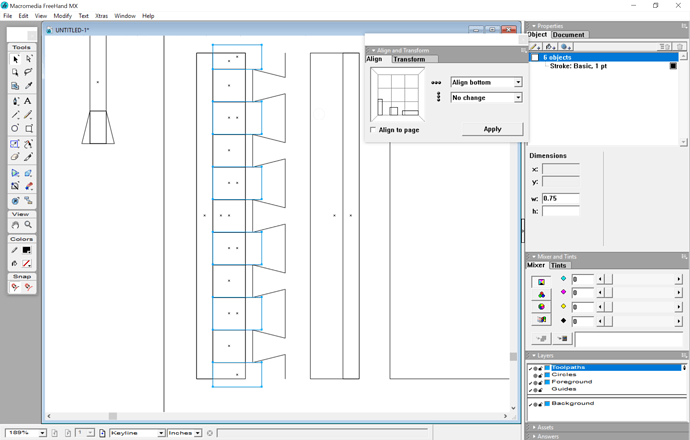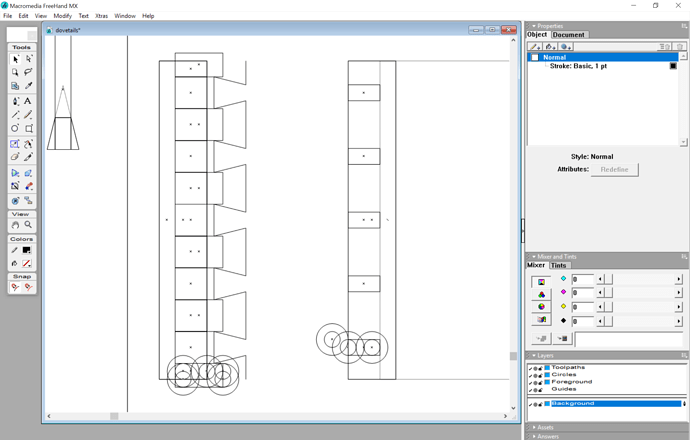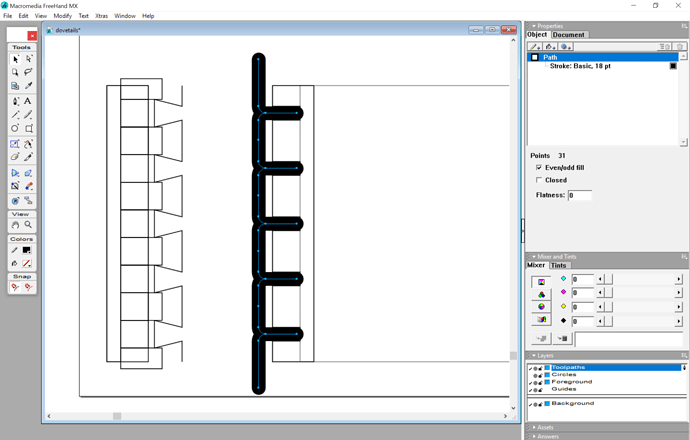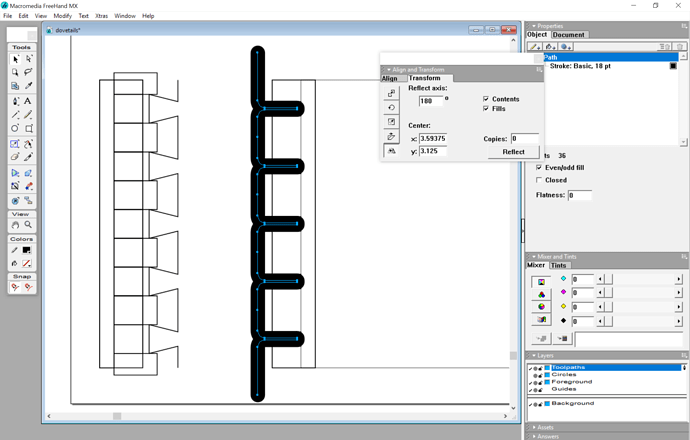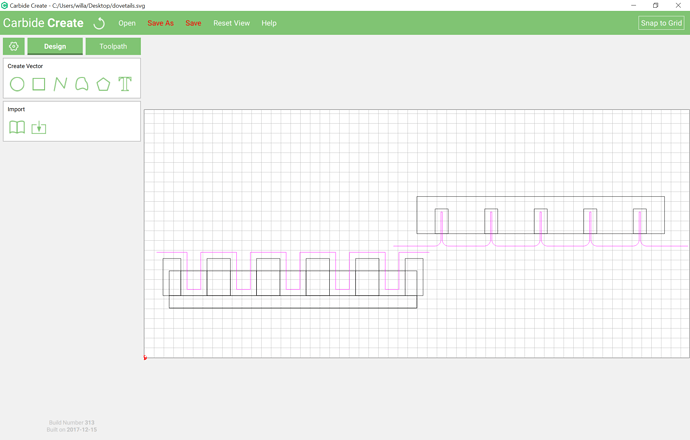Hi All
I am new to this entire process. Have anyone created any dovetail joints using Carbide Create? If you have can you please upload a your carbide create file.
Thanks in advance
Carbide Create can’t directly do dovetails with a preview — they require undercuts which it can’t model.
If you used a dovetail router bit and a jig which held two boards at right angles at the front of the machine you could do this — but you wouldn’t be able to get a preview in Carbide Create and you’d have to work up suitable feeds and speeds (you’d probably want to use a square endmill to clear the bulk of the area first).
There are a number of alternative options — fingerjoint boxes are pretty straightforward and I worked up instructions here:
The community has some notes on joinery at: Shapeoko CNC Router, Rigid, Accurate, Reliable, and Affordable
I refuse to believe that carbide create “Can’t” directly do dovetails. My Carbide Create is my BABY. I know there are plenty of smart people in this forum that think out of the box and have made it work. Folks if you have done dovetails OR finger joint box please upload the carbide create files (no instructions just files). I am sure other people would like to see and and maybe can make addition modifications to the files.
It can directly do dovetails — you just need to make a jig and create the toolpaths manually and create the cuts without any sort of 3D visualization in Carbide Create — you might be able to find a 3rd party tool for this: [spoiler]Shapeoko CNC Router, Rigid, Accurate, Reliable, and Affordable Shapeoko CNC Router, Rigid, Accurate, Reliable, and Affordable
There is a file on the link which you didn’t click:
Yes! I am glad that you agree that Carbide Create can do it. I was doing it manually and then i got frustrated and decided to reach out to the smart community. Sounds like you have done it manually before can you please share your carbide create file.
Thanks
Such a file would be specific to a particular size of box and dovetail bit geometry — please specify both and we’ll work up the instructions for doing this
Hello and sorry for the late response below is the details
3/8 Dovetail Bit
3/8 Height
9 Degree
1/4 Shank
Box size = 20 incehs X !0 inches
Wood Detail
20 inches long
5 inches wide
3/4 inch wood
Please let me know if you need additional information
One concern I have there is that is a very small bit for such thick stock.
I’d suggest using something with a cutting depth of at least 2/3rds the stock thickness (if you’re going to do half-blind dovetails) and of necessity if you’re going to do through dovetails you’ll need something which can cut deeper than your material thickness (this would also entail some manual post-processing w/ either a float and/or a saw and/or a chisel).
I picked up a pair of boards and the first suitable endmill I found was a Diablo 1/4" shank, 1/2" diameter, 1/2" cutting depth, 14 degree dovetail bit, 1 7/8" o.a.l. at the local Home Depot.
Top and bottom of the box weren’t specified either, so I picked up some 1/4" (5.2mm) lauan plywood which will float in grooves.
How the box will open wasn’t discussed either, so we’ll do the traditional cutting in half.
First up we’ll model the box in 3D.
Actually, it’s been a long time since geometry in high school.
Instead, it’s more straight-forward to just draw this up — we start with the endmill itself since it and the stock dimensions as discussed above are the fundamental constraints.
Since the dovetail bit we have selected can only cut to a depth of 1/2", we have to leave 1/4" uncut for the blind dovetails, and we have to determine if we will draw up the pins or tails first. Folks do it both ways, and there are numerous arguments for tails first:
We’ll do tails first since that is the board which is held vertically and a bit easier to visualize.
The next consideration is how many pins / tails there will be — as noted, we are constrained by the endmill geometry in a way that we are not when cutting by hand, so the tails have to be greater than 0.5" at their largest dimension, and must be at least 0.25" at the base. With a 5" tall box, we will simplify this and have 5 tails/pins, with a half pin at the top and bottom.
One way to do this visually is to draw up a side view of the tails, evenly arrange the tips and then use the drawn up tool to line things up:
With that done, we can begin to draw in boxes to represent what will be cut and what will be left behind.
One has to consider that one will be working with a 1/4" endmill which will be cutting from the center out in Carbide Create, but the actual path ultimately will be the dovetail bit which will cut a 1/2" diameter at the bottom. We will need to leave clearance at blind side to ensure the dovetail bit doesn’t blow out, and overcut on the other to ensure that we will have a clean, square cut of the sides of the tail — drawing in some circles will help to visualize this:
This results in the following areas which need to be cut from the end of the board to make the tails:
Probably it would be best to make two cuts, one with a square endmill to clear the center, then a second cut as an inside contour pass with the dovetail bit — note that it will be necessary to work up the path so that it plunges from a point where it will not remove material which needs to be preserved.
(This is why it was originally noted that Carbide Create can’t directly do this — one will either need to edit the G-Code by hand or work up the orientation of the geometry so as to ensure that there are no such difficulties)
WillAdams this is some awesome work you have done do you have a copy of the carbide create file? I am confident if you provide the file I can do some additional work on top of the great stuff that you have done. What is the best way to upload the file to the forum. I am sure others will benefit from this too.
If you follow along you should be able to make your own Carbide Create file.
For the pins, just add some circles to help envision how the toolpath should work:
Then go back and adjust paths as needed for:
- cuts w/ a 1/4" endmill to clear the pockets to the depth of the cut
- clearance for the endmill when making the pockets
- draw in paths for the dovetail bit to cut along a no offset contour path
- then verify that things will fit together
- then arrange the paths in Carbide Create to cut the pair with the tails being cut out of the board held vertically and the pins cut out of the board held in place on the machine
Drawing in the toolpaths, one can verify them by assigning suitable strokes:
Adjust slightly to not have overlapping paths:
Arrange things so that you’ll be able to cut the pins on the horizontal board on the machine, and clamp the board for the tails to the front:
Import that into Carbide Create and adjust the size to scale and set things to a centered origin:
Set the origin to the center of the stock and align the corner of the board against it. Adjust the pockets and cut them to the desired depth using a suitable endmill, then set up a different tool for the dovetail bit and assign a toolpath which has a depth per pass sufficient to ensure that only one pass will be made.
dovetails.c2d (155.5 KB)
EDIT: Sleeping on it, I believe the board which is held vertically needs to have its toolpaths adjusted — they need to be cut all the way through — it’ll also need to be shorter by twice the blind depth left in the other board.
Just for compleatness’ sake, there are a couple of commercial software programs which address this sort of thing. You may want to consider:
Hi William
I just ordered the software from tailmaker. it seems like it will do the trick. I will test it out this weekend and keep you posted. Thanks so much for all you EXCELLENT assistance.
keep us posted please  looks really cool
looks really cool
Glad the commercial software looks suitable for you — I’ve been considering being one (or both) of those myself.
In the meanwhile, turns out that there are a couple of options for 3D modeling these in OpenSCAD:
- https://www.chrisfinke.com/2017/01/10/generating-dovetails-in-openscad/
- https://github.com/hugokernel/OpenSCAD_Dovetail
- https://www.thingiverse.com/thing:27466
So I’m going to revisit 3D modeling and sort out simultaneously modeling and drawing these up so that we can get paths cut.
